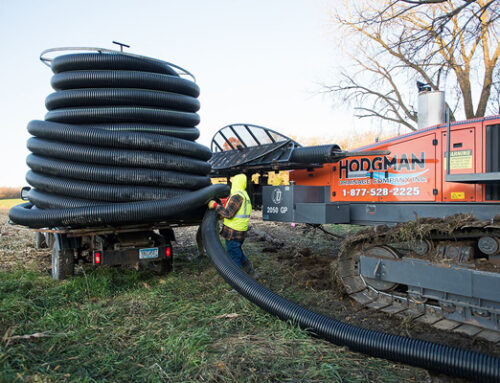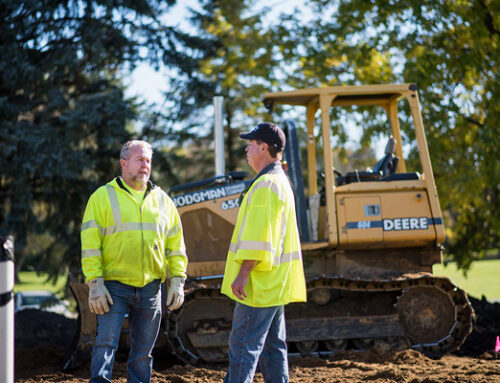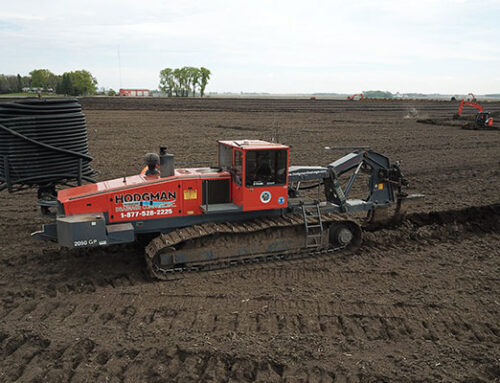Key Takeaways:
- Soil moisture directly affects the type of crop grown. Excess water can lead to hydric & infertile soils. So, drainage solutions like field tiling are utilized to restore the soil’s ability to bear specific crops without nutrient depletion.
- Wet soils lead to a decrease in oxygen, resulting in organisms dying off, which disrupts the cycle of nutrient replenishment of the soil.
- Poorly drained fields lead to root rot & reduced crop yields, and poor tiling installations can make matters worse by disrupting drainage & chemical leaching.
- Enlist the services of a capable drainage contractor for tiling projects to ensure compliance with sustainable ordinances & guaranteed results of sophisticated drainage to enhance crop yields.
Plants & crops need water to grow. Right. They also need moist soil to collect nutrients from it. Agreed. If you are new to farming, you might wonder why Minnesota’s well-drained & wet soils are facing such an issue. Why and what is field tiling? Why drain the land of excess groundwater? Shouldn’t it be a productive asset to the land tract?
Reality is disappointing if you put agricultural economics in perspective. Growing communities, higher birth rates, more remote regions populated, and better living standards correlate to the exponential need for food. Now conventional farming methods don’t quite cut it and using chemicals like phosphates, nitrates, and pesticides negatively affects soil longevity & groundwater quality. So there had to be a win-win solution, and a sustainable drainage solution was it!
In the 70s, farmers started by burying sections of clay pipes in trenches. Today, Hodgman Drainage Company, Inc. brings you the latest in perforated PVC field tiles for optimal soil moisture control.
Land Drainage Solutions | Field Tiling
Minnesota soil is a mix of well-drained loam with thick peat topsoil from its glacial past. The rich prairie soil and isolated and vast aquifers make the state renowned for its fertile soil. However, the issue of waterlogged soils in swamps & wetlands and a high-water table makes it difficult to farm successfully without a sustainable technological intervention.
Enter field tiles. These are perforated short PVC pipes laid 30 to 100ft apart in an extensive network of trenches fed by interspersed drains, leading to a controlled outfall like a lake or reservoir. It’s a miracle of agricultural advancement that has helped reclaim much of the state’s wetlands for farming corn & soybean and furthered growing a fast-tracked crop for high-quality silage without exhausting the soil.
What Do Wet Soils Do to Your Crop?
Soil comprises decaying plant matter like plant leaves & roots, animal excrement, minerals, and microorganisms that biodegrade organic matter. These organisms are living entities that require oxygen to function. They degrade the organic matter to release vital nutrients that make the soil fertile.
When there is too much water in the soil, that drives out the oxygen & makes it denser for microorganisms to survive & break down plant matter. The plant roots begin to rot instead of breaking down to release nutrients. Unfavorable plant species adapted to waterlogged soils take over, and crop yield suffers.
Excessive use of fertilizers to restore soil fertility only exacerbates current conditions. Installing a land drainage solution like field tiling is the only way out.
Good Field Tiling Best Practices
Compensate For Soil Compaction | Field Tiling
Plowing might not be sufficient if your land has been subject to compaction over many years – usually resulting in damaged soil. You can upgrade to a deeper type of field tiling. The process will thoroughly aerate the field & help restore soil quality.
Check For Field Blowouts
Older tiles were made of clay and are still in place on many farms across Minnesota. These have been phased out because of material costs & because they tend to collapse from soil compaction. Inspecting the fields for blowouts that may indicate a tile failure is ideal. An even better solution is to consider upgrading to modern tiling solutions for a lasting effect & benefit to soil quality.
Target The Field, Not A Spot
Farmers sometimes opt to target a specific wet spot on their fields to drain. This is often done to cut down costs of full-field tiling. Spot-targeting does not do much to lower the water levels in the entire field, so it is optimal to go with a full-scale land drainage solution.
Tilted Tiling for Farming Plains | Field Tiling
Flat land is challenging to drain, which is why another best practice is to install drains at an angle to the tile. That way, the excess water is gravity fed into the tile, leading to the outflow with minimal environmental impact. It also helps restore the natural balance of soil nutrients to the land for further farming.
What Influences the Choice of Subsurface Drainage?
Soil Type
As is evident in land drainage, flat, dense soils with retarded water runoff and wet soils due to higher water tables are best for implementing field tiling. Even soils located over aquifers present heightened soil fertility & quality from installing drains & tiles.
Suppose the region to be developed is a wetland. In that case, a combination of water pumps & interceptor field tiles can help restore the land to a farmable state.
Topography
Flat terrain does well with mole drains installed at a slope to the collector tile. That helps gravity-feed the excess water towards the outflow. For bulky & rocky soil that tends to have numerous wet spots & dry patches, gravel mole drains offer an effective land drainage solution. Interceptor drains are recommended for hilly pastureland and farm fields. They help offset the imbalance caused by surface runoff where a hilly decline levels out into a field.
Local Precipitation
The rainy season can put a stopper on crop cultivation, given that the soil is in danger of being water-saturated. That could lead to root rot & seed damage. Minnesota experiences snow & rain for most of the year, which justifies a robust network of urban & rural drainage solutions. Field tiling is among the most effective ways for farmers to deal with excess soil moisture without disrupting the natural balance of nearby aquatic ecosystems and springs.
Outfall Design & Location | Field Tiling
Field tiles collect water from the drains & carry it to an outfall that might empty into an aquifer, a lake, or a reservoir. Poorly designed outfalls can contribute to isolated flooding or water-inundation of low-lying areas. Wet soils can be moisture-rich or waterlogged, might be well-drained, but receive much rain in a single season. The amount of water to be drained should be accounted for in the number of collection channels & the number of outfalls to an accommodating drain site.
Securing the Right Tiling Contractor | Field Tiling
Having the right drainage contractor survey and assess your land and your livelihood is critical to the success of field tiling. Tiling is meant to be a conservation practice aimed at maximizing crop yields over limited acreage to preserve the natural habitat. Not implementing best practices in a drainage solution will only exacerbate the surface runoff quality and result in uncontrolled soil drainage.
It is important to secure a contractor that is familiar with the lay of the land, soil quality, survey maps & a wide range of federal & state compliant tiling solutions.
Have Your Land Assessed Today!
Hodgman Drainage Company, Inc., serving Dodge Center, MN, and the agricultural professionals in the region, has delivered a range of sophisticated drainage solutions for rural, agricultural, and urbanscapes since 1982. We will survey your land for soil quality & vulnerabilities and lay out a plan to stabilize soil moisture while enhancing soil fertility for sustainable farming & water-body replenishment.
Please feel free to contact us at 507-528-2225. Thank you for considering our drainage services!



